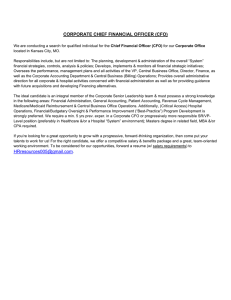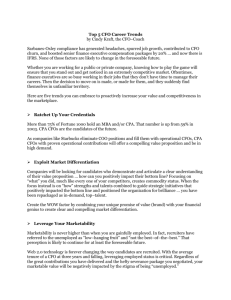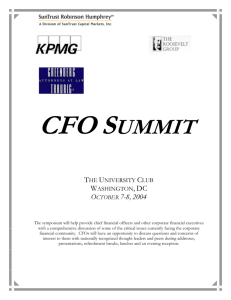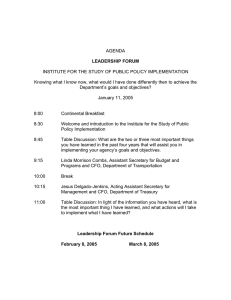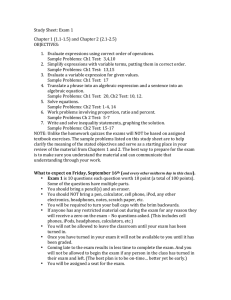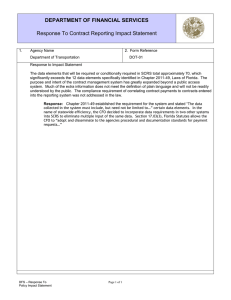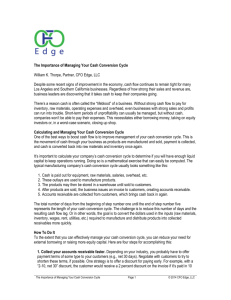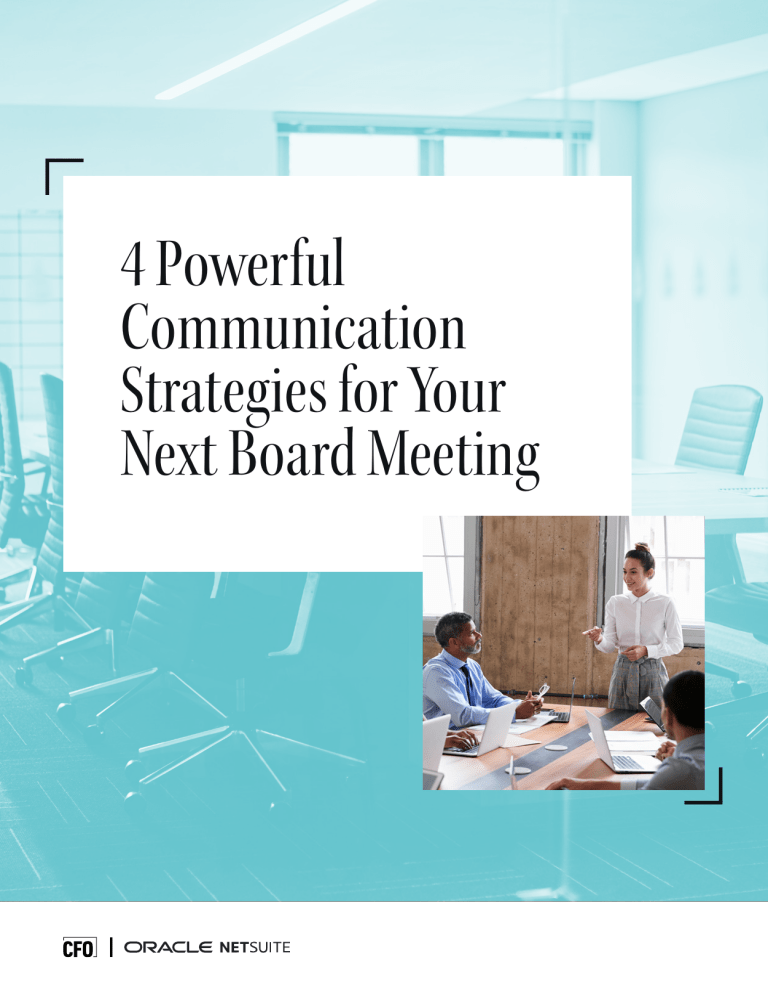
4 Powerful Communication Strategies for Your Next Board Meeting T he current junction of economic stress factors has must accept the business impact of these left the corporate boardroom a cauldron for economic challenges and openly plan through potentially difficult conversations. Continued inflation1, changing scenarios to evolve company strategies. expected Federal Reserve increases to interest rates2, In doing so, the CFO can shine a light on practical falling consumer confidence3, and a steep decline in realities facing the company by bringing their manufacturing outlook4 have given CFOs a plethora of real-time reports to the table for the board’s developing themes to address in board meetings. consideration, support, and advice. Still, every meeting the CFO has with the board of In a volatile and contracting economy, a CFO’s directors provides opportunities for an insightful comprehensive and consistent communications planning session. It can address how companies have approach with the board is paramount. It is continued to grow — despite 2022’s volatile economy critical for successful teamwork and for arriving — while managing headwinds for future growth. As finance chiefs examine their daily dashboards, they CFO Skills Toolkit: Communications at mutually agreed-upon financial agendas to drive the company forward. 2 4 STRATEGIES TO AMPLIFY COMMUNICATION WITH THE BOARD DURING ECONOMIC VOLATILITY 1. CFOs should meet with the C-suite for a pre-board huddle CFOs shouldn’t craft a financial overview presentation revenue, and new business acquisition support the for the board in a vacuum. mission. Pre-board meeting conversations should map Delivering a purpose-driven board meeting and staying on track starts well in advance. CFOs should meet with the rest of the C-suite ahead of time to agree on the out how each respective leader’s directives fit into the overall mission narrative and how each will contribute to the presentation in kind. order and arrangement of the presentation and where it The CFO’s message brings gravity to the company’s is appropriate to address financial performance. The situation, as it is grounded in measured past CEO sets the tone for the company’s overall mission and performance and a calculated expectation of future strategy. The CEO’s colleagues will have the opportunity outcomes. Use this advance time to update the to provide context on how finance, operations, sales management team on any changes in the company’s financial performance or changes in future projections. Pre-board meeting conversations should map out how each respective leader’s directives fit into the overall mission narrative and how each will contribute to the presentation in kind. Ultimately, the CFO’s presentation should dovetail with the CEO’s strategic vision to be presented. These pre-board meeting huddles will also allow the C-suite to hash out unmet performance expectations and prepare in advance to receive hard questions from the board. If the previous reporting period’s financials failed to meet projections, the CFO can prepare with the team to discuss what happened and how leadership will change course in future periods, so expectations are met. CFO Skills Toolkit: Communications 3 2. Finance conversations with the board should emphasize strategy CFOs are known for a pragmatic, data-focused approach allow directors to offer insight based on both the to company strategy. When they bring their detailed presentation of historical data and future forecasts. perspectives to the board, the meetings become an opportunity to help directors understand the companies’ current financial strategy within the context of the economic environment. This is furthered when CFOs After the CEO opens the meeting, the CFO will step in with high-level data and financial metrics. CFOs should avoid getting too far in the weeds, but also be prepared to open up the floor for debate to further break down the analysis. The lessons go both ways, according CFOs can benefit from effective relationships with board directors ... who can share external perspectives and act as a thought leader and sparring partner.” to McKinsey5: “CFOs can benefit from effective relationships with board directors ... who can share external perspectives and act as a thought leader and sparring partner.” These meetings will give CFOs time to discuss a number of critical strategies, including inflation’s impact on their organization’s access to capital, pricing adjustments, and supplier relationships. Boards may provide guidance McKinsey on what is blocking the company from access to capital, revenue growth, or freeing up cash to remain liquid. Conversations with the board are a good place to explore specific strategic actions and tap into the collective strategic minds of the audience. Some might include: • D iscussing the pros and cons of a potential merger and acquisition. • A nalyzing an opportunity for a future investment, or a need for a future cash infusion. CFO Skills Toolkit: Communications • D iscussing whether the company should increase headcount to support growth initiatives, and what that would mean for the company’s financial reporting and near-term and long-term profit margin. • R eviewing a technology roadmap and exploring benefits. • D iscussing the value and approach to environmental, social and governance initiatives. 4 3. Prepare the board for transparent and ongoing coversations Communication between the C-suite and board should Landon Cortenbach, CFO at MSH, a global talent happen regularly so that actions and decisions are advisory firm. never a surprise. That transparent dialogue will benefit from an ERP system6 that provides dashboards that allow the board and executives to see the same real-time information ahead of a meeting. Then the meeting can be more about an informed discussion, based on financials, to determine the next steps to The guiding principle for me, regardless of the audience, is authenticity and transparency.” improve the business. “The guiding principle for me, regardless of the Landon Cortenbach, CFO at MSH audience, is authenticity and transparency,” said Board meetings don’t need to be a one-way street of information. CFOs can also bring complex questions to the table and allow the board to discuss areas that might need clarification. Such questions might include: • Is the company using the right key performance indicators (KPIs)? • Is the company becoming too reliant on too few revenue streams? Should revenue diversification become part of strategy? • W hat financial risk do board members see from their perspective? CFO Skills Toolkit: Communications 5 4. Practice your presentation and make it accessible A finance chief’s presentation must be crafted for each situation so that the board can help solve problems and provide insights. CFOs should rely on a predictable presentation format so the board can anticipate the flow of the meeting, but also set a tone appropriate to the circumstances of the message. Clear communication from the CFO will let board members understand how the company is doing and what decisions executives are evaluating. Information should be timely, accurate, and within the range of expectation; there should be no surprises. Cortenbach offers this advice: “I try to lead with contextually relevant information that is synthesized in a way where I’m not overly taxing their brains to understand it. That’s always the key for me, because if I’m diverting them from having an open dialogue to solve business problems into trying to understand what I’m saying — in a deck or a financial report — then we’ve lost the importance of the meeting.” CFO Skills Toolkit: Communications 6 CONCLUSION A good board covers a diversity of expertise and experience that supplements the wisdom of executives. “I’ve had boards that were highly financially astute. They wanted to get really deep into certain [finance-specific] things,” said Cortenbach. “But I’ve had others where they cared more about the high-level perspective.” Respecting these differences can additionally facilitate the relationships and interpersonal dynamics between the CFO and the board members. I’ve had boards that were highly financially astute. They wanted to get really deep into certain [finance-specific] things. But I’ve had others where they cared more about the high-level perspective.” Board members are aware of the current economic challenges and will likely have rich experience dealing Landon Cortenbach, CFO at MSH with previous cyclical challenges. Talking to your board — often — is good for business. Keep communication lines open and utilize them often. Navigate potential pitfalls • T he meeting agenda is sacrosanct. Respect everyone’s time and expectations for the meeting. • Y our C-suite team has a scripted playbook for a reason. But, be prepared to answer questions if the board asks them. CFO Skills Toolkit: Communications • R emember “The Godfather” – “Mr. Corleone is a man who insists on hearing bad news immediately.”7 Give the board ample time to react, digest, ask questions, and help develop a path forward in an adverse economic climate. • N o surprises! Consider presenting any unusual news individually before the meeting. 7 SOURCES 1 https://www.bls.gov/cpi/latest-numbers.htm 5 ttps://www.mckinsey.com/capabilities/ h strategy-and-corporate-finance/our-insights/ how-cfos-can-better-support-board-directorsand-vice-versa 2 https://www.cmegroup.com/trading/ interest-rates/countdown-to-fomc.html 3 https://www.conference-board.org/topics/ consumer-confidence 6 https://www.netsuite.com/portal/products/ erp/financial-management.shtml 4 https://www.newyorkfed.org/survey/empire/ empiresurvey_overview.html 7 ttps://www.imdb.com/title/tt0068646/ h quotes/qt0361879 CFO Skills Toolkit: Communications 8 For more than 20 years, Oracle NetSuite has helped organizations grow, scale, and adapt to change. As the #1 Cloud ERP, NetSuite provides an integrated system that includes financials/ERP, inventory management, HR, professional services automation, and omnichannel commerce, used by more than 32,000 customers in 217 countries and dependent territories. Learn more about NetSuite and supply chain management solutions here. Like us on Facebook, and follow us on LinkedIn, Instagram, and Twitter. Learn More
